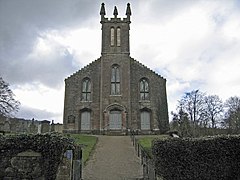Human settlement in Scotland
Clunie
| |
|---|---|
 Clunie Church Clunie Church | |
 | |
| OS grid reference | NO109438 |
| Council area | |
| Lieutenancy area | |
| Country | Scotland |
| Sovereign state | United Kingdom |
| Post town | BLAIRGOWRIE |
| Postcode district | PH10 |
| Dialling code | 01250 |
| Police | Scotland |
| Fire | Scottish |
| Ambulance | Scottish |
| UK Parliament | |
| Scottish Parliament | |
| 56°34′40″N 3°27′07″W / 56.577645°N 3.451953°W / 56.577645; -3.451953 | |
Clunie is a small settlement in Perthshire, Scotland, four miles (six kilometres) west of Blairgowrie. It lies on the western shore of the Loch of Clunie.
History
Near the village on a small hill are the foundations of an early defensive settlement. The fortifications on the site date back to the 9th century and even Iron Age material has been discovered at the site. There is also evidence of defensive structures nearby to this hill fort dating back to the Roman period. One notable use of this hill site was by Kenneth MacAlpin, the first king of Scotland, as a base for hunting in the nearby royal forest of Clunie. English troops occupied the site following their victory at the Battle of Dunbar during the First War of Scottish Independence.

On a small island (formerly a crannog) in the loch stand the remains of Clunie Castle, a tower house of the bishops of Dunkeld.
The current parish church in the village dates from 1840, designed by Perth architect William Macdonald Mackenzie, replacing a previous structure with a new bell tower. Within the grounds stands a mausoleum with a romanesque doorway thought to be from an earlier 12th- or 13th-century church that stood on the same site. The church is now linked with those at Kinclaven and Caputh.
There is a cairn style war memorial in the village park which was erected in 1946 to mark two locals who lost their life in World War II. The cairn also displays nine names of soldiers from the area who died during World War I.
Clunie village hall dates from 1912 and is still used by the local community for functions, clubs and events.
Notable people
Clunie is the birthplace of John Macleod, co-recipient of the 1923 Nobel prize in Physiology or Medicine.
References
- Munro, David M.; Gittings, B. M. (2006). Scotland : an encyclopedia of places & landscapes. Glasgow: Collins. ISBN 978-0-00-472466-9. OCLC 225152110.
- ^ "Clunie Castle | Perthshire, Kinross, Angus and Fife | Castles, Forts and Battles". www.castlesfortsbattles.co.uk. Retrieved 3 March 2020.
- ^ "Parish of Clunie from The Gazetteer for Scotland". www.scottish-places.info. Retrieved 4 March 2020.
- "History of Clunie, in Perth and Kinross and Perthshire | Map and description". www.visionofbritain.org.uk. Retrieved 3 March 2020.
- William Macdonald Mackenzie - Dictionary of Scottish Architects
- "Clunie Parish Church - Clunie, Tayside - Places of Worship in Scotland | SCHR". scottishchurches.org.uk. Retrieved 4 March 2020.
- "Clunie, Old Parish Church | Canmore". canmore.org.uk. Retrieved 4 March 2020.
- Lowson, Alison (17 March 2011). "Rev. Peggy Roberts was inducted to the parish of Caputh and Clunie linked with Kinclaven". dailyrecord. Retrieved 4 March 2020.
- "Clunie Parish". Imperial War Museums. Retrieved 3 March 2020.
- "Home - Clunie Hall". www.cluniehall.co.uk. Retrieved 4 March 2020.
- "The Nobel Prize in Physiology or Medicine 1923". NobelPrize.org. Retrieved 4 March 2020.